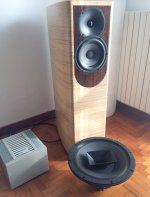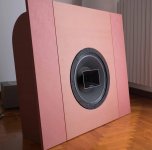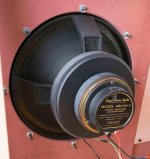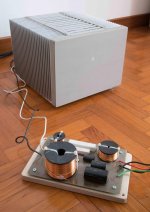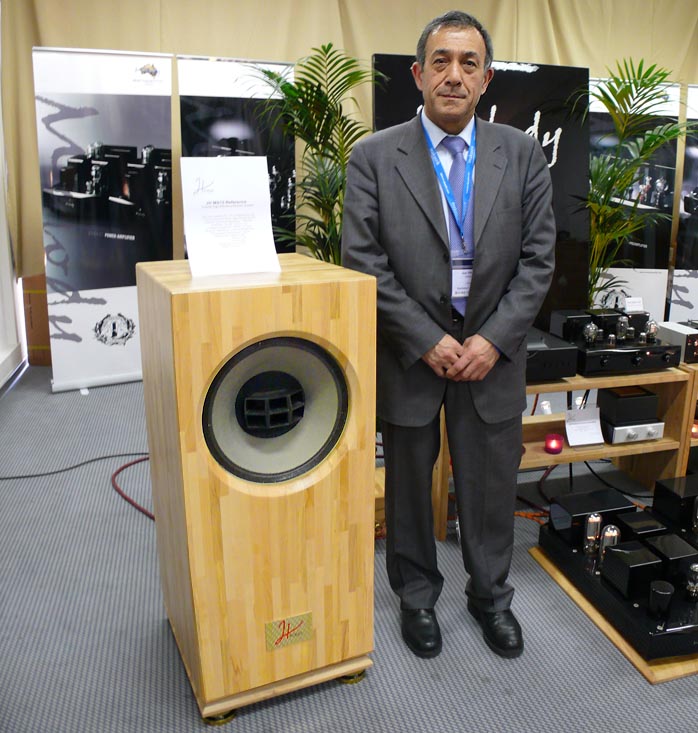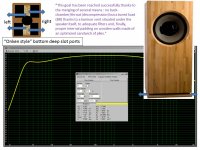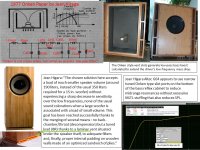Hello,
I've just bought me a used pair of GPA 604-8H-II in pristine condition, along with the original N 604 8A xover filters.
Compared to my Troels' DTQWT drivers, these things are huge !
I put them in an open baffle (JE Labs style) and hooked to my Pass F5 monos.
At first, the speakers where mounted behind the panel, leaving a 40mm tunnel in front of them.
Big mistake. They were almost unlistenable with canned voices and muffled mids.
So I reoruted the boards as shown in pictures and mounted the salad bowls flush with the panel.
Far better. With some musical genres they play very nicely. The compression driver is in another league if compared to a dome.
Listening to a jazz trio is kind of mesmerizing.
But, they are (very) far from perfection. Image is low, bass is lean and human voices still need a correction.
Overall, my DTQWT's are better speakers, more able to cope with many music genres, although they miss the magic of the big coaxials.
So, time for some questions to the experts.
As a first upgrade I want to try this Jeff Markwart's filter:
Great Plains Audio 604-8H-III - Great Plains Audio
I'm going to build it with Jantzen's Air Cores and Cross-Caps. Then maybe in future the caps will be replaced with better ones.
I don't understand the attenuators schematics. I'd like to replace them with resistors, swapping them until I find the correct value.
Where I have to place a resistor for HF eq? Left side of L2 to C3, or right side of L2 to C3 ?
About MF eq I guess that the resistor goes from between R1-R2 to R3, right ?
Which range of values to allow let's say five steps of attenuation ?
Then I'll be back for suggestions about a proper cabinet style. Stonehenge, MLTL.. a lot of fun to come
Thanks in advance! Carlo.
I've just bought me a used pair of GPA 604-8H-II in pristine condition, along with the original N 604 8A xover filters.
Compared to my Troels' DTQWT drivers, these things are huge !
I put them in an open baffle (JE Labs style) and hooked to my Pass F5 monos.
At first, the speakers where mounted behind the panel, leaving a 40mm tunnel in front of them.
Big mistake. They were almost unlistenable with canned voices and muffled mids.
So I reoruted the boards as shown in pictures and mounted the salad bowls flush with the panel.
Far better. With some musical genres they play very nicely. The compression driver is in another league if compared to a dome.
Listening to a jazz trio is kind of mesmerizing.
But, they are (very) far from perfection. Image is low, bass is lean and human voices still need a correction.
Overall, my DTQWT's are better speakers, more able to cope with many music genres, although they miss the magic of the big coaxials.
So, time for some questions to the experts.
As a first upgrade I want to try this Jeff Markwart's filter:
Great Plains Audio 604-8H-III - Great Plains Audio
I'm going to build it with Jantzen's Air Cores and Cross-Caps. Then maybe in future the caps will be replaced with better ones.
I don't understand the attenuators schematics. I'd like to replace them with resistors, swapping them until I find the correct value.
Where I have to place a resistor for HF eq? Left side of L2 to C3, or right side of L2 to C3 ?
About MF eq I guess that the resistor goes from between R1-R2 to R3, right ?
Which range of values to allow let's say five steps of attenuation ?
Then I'll be back for suggestions about a proper cabinet style. Stonehenge, MLTL.. a lot of fun to come
Thanks in advance! Carlo.
Attachments
Good for you! I once worked in a large electronics store that sold Altec, along with other classic and exotic lines (showing my age). The Stonehenge V was lusted after by many employees and customers alike. The 604 series drivers just seem to have an appeal all there own.
I occasionally consider building what the custom car community would call a Resto-Mod, a classic restored and improved with current technology. In my case would stick with the classic Stonehenge cabinet, but use up to date amplification and FIR filters. Just my idea, not suggesting you take that path. I look forward to seeing how things progress with your new treasures!
KJK
I occasionally consider building what the custom car community would call a Resto-Mod, a classic restored and improved with current technology. In my case would stick with the classic Stonehenge cabinet, but use up to date amplification and FIR filters. Just my idea, not suggesting you take that path. I look forward to seeing how things progress with your new treasures!
KJK
If you first select a cabinet and simulate your room placement, you will be able to construct the best crossover with just one investment.
A MLTL cabinet can be built/tuned to reduce many resonances better than the basic-big-box.
The popular 6041 studio monitor includes a bottom 416-8C woofer for both deeper bass, plus a midbass crossover frequency which allows a sealed box GPA 604 improved midrange clarity.
http://audio-heritage.jp/ALTEC/speaker/6041(3).jpg
A MLTL cabinet can be built/tuned to reduce many resonances better than the basic-big-box.
The popular 6041 studio monitor includes a bottom 416-8C woofer for both deeper bass, plus a midbass crossover frequency which allows a sealed box GPA 604 improved midrange clarity.
http://audio-heritage.jp/ALTEC/speaker/6041(3).jpg
... suggestions about a proper cabinet style. Stonehenge, MLTL...
We have had a number of builds of the Woden Bison ML-TL with good results.
An externally hosted image should be here but it was not working when we last tested it.
dave
Capacitors aren't that critical in the crossover, just pick good quality polyproplylene caps. Air core doesn't cut it in the low pass filter, a huge cored inductor with low DCR (below 100 mOhm) is the ticket for 604s. The shelving filter can be removed from the Markwart circuits.
Thank you everyone for the suggestions!
The ML-TL Woden Bison seems interesting, but it is damn big! Looks like a 300 liters plus the space under the bottom vent.
What if the port is moved to the front panel, and the driver placed closer to the top, keeping the same volume and inner structure ? Does it degenerate to a plain bass reflex, Altec 620 style, only bigger?
I'm not interested in squeezing the last hertz from bass response but, is the ML-TL concept far superior ?
By the way, I've moved the OB panels closer to the front wall, about 2,5ft. The mid-bass has improved, cello and upright bass are very enjoyable now.
I can't think of a simpler or cheaper speaker able to fill a smallish room with this kind of musical quality.
The ML-TL Woden Bison seems interesting, but it is damn big! Looks like a 300 liters plus the space under the bottom vent.
What if the port is moved to the front panel, and the driver placed closer to the top, keeping the same volume and inner structure ? Does it degenerate to a plain bass reflex, Altec 620 style, only bigger?
I'm not interested in squeezing the last hertz from bass response but, is the ML-TL concept far superior ?
By the way, I've moved the OB panels closer to the front wall, about 2,5ft. The mid-bass has improved, cello and upright bass are very enjoyable now.
I can't think of a simpler or cheaper speaker able to fill a smallish room with this kind of musical quality.
Last edited:
Bison is actually smallish as far as 606 enclosures go. The vent can be moved to any of the sides (at the bottom). Those alternate drawings are supplied with the planset.
http://wodendesign.com/downloads/Bison-extents-0v82-071217.pdf
dave
http://wodendesign.com/downloads/Bison-extents-0v82-071217.pdf
dave
The Onken concept for sure gives strenght to the structure.
Hiraga's are very styilish, so bad he's not giving away the plans
A Hiraga-like cabinet with wider baffle and more internal volume should be both handsome and good sounding.
The slot port on the base can be made highly tunable by building it as a round of small ports.
Closing/stuffing some of the ports would allow to "tune" the bass emission with the room.
Hiraga's are very styilish, so bad he's not giving away the plans
A Hiraga-like cabinet with wider baffle and more internal volume should be both handsome and good sounding.
The slot port on the base can be made highly tunable by building it as a round of small ports.
Closing/stuffing some of the ports would allow to "tune" the bass emission with the room.
I found this page on Jeff Markwart's Corner
Phase Correction for Altec Ferrite Duplexes - Great Plains Audio
As explained there, I've decided to get rid of the MF-LF attenuators and ordered the parts for the plain filter here:
Great Plains Audio 604-8H-III - Great Plains Audio
Let's see how much better it sounds when compared to the stock crossover..
About the above Hiraga's product, I can see the reason why he's using laminated hardwood instead of birch ply.
Compared to the Bison made of two layers of ply, this cabinet looks more straightforward to build and finish.
Phase Correction for Altec Ferrite Duplexes - Great Plains Audio
As explained there, I've decided to get rid of the MF-LF attenuators and ordered the parts for the plain filter here:
Great Plains Audio 604-8H-III - Great Plains Audio
Let's see how much better it sounds when compared to the stock crossover..
About the above Hiraga's product, I can see the reason why he's using laminated hardwood instead of birch ply.
Compared to the Bison made of two layers of ply, this cabinet looks more straightforward to build and finish.
Last edited:
Thanks Pano.
My open baffle is only a quick temporary arrangement.
A final enclosure will be possibly a Hiraga style, I like how it looks.
About OB plus helper woofer, how do you rate it ? Is it worth the cost, size an complexity ?
I'm not after strong bass for electronic music, more interested in smooth reproduction of the bass frequencies as you can hear from a live orchestra, or jazz combo.
My open baffle is only a quick temporary arrangement.
A final enclosure will be possibly a Hiraga style, I like how it looks.
About OB plus helper woofer, how do you rate it ? Is it worth the cost, size an complexity ?
I'm not after strong bass for electronic music, more interested in smooth reproduction of the bass frequencies as you can hear from a live orchestra, or jazz combo.
Jean Hiraga's personal explanation of his Altec 604-alnico cabinet construction draws-out like putting large Onken style ports on the bottom of the cabinet.Hiraga's are very styilish, so bad he's not giving away the plans
====SUMMARY: MLTL for GPA 604 using 48" x 96" plywood 11.5cuft empty, ~10cuft net
Internal length = 46"
Internal width = 24"
Internal depth = 17"
Center GPA 604 at 14.9" below the internal top
Center 1.5" long, 4" diameter port 4.2" above internal bottom
=============
====SUMMARY: MLTL for GPA 604 using 60"x60" Baltic Birch Plywood 14.5cuft empty, ~12.5cuft net
Internal length = 58"
Internal width = 24"
Internal depth = 17"
Center GPA 604 at 18.7" below the internal top
Center 3" long, 4" diameter port 5.3" above internal bottom
===========
====Basic TL math.
1) Using the TL calculator, the T/S parameters for the GPA 604-8H-III recommend a transmission line cross section area of 405sqin.
2) The W*D aspect ratio is selected to both reduce line resonances and balance (wide= low baffle-step frequency) and (deep = attenuate rear cone reflections)
...2a) Using an irregular X*Y ratio like 1: 1.414 produces internal dimensions of W=23.9" D=16.9". ==> reasonable balance.
...2b) Using golden ratio of 1: 1.618 produces internal dimensions of W=26.6" D=15.8". ==> too shallow.
3) Baltic Birch plywood comes in 60" x 60" sheets, which favors a 58" maximum internal line length. ==> 3-sheets for 2-cabinets
4) MLTL math: If the driver is offset at 0.324x (slightly less than 1/3 the length of the straight transmission line), the 3/4 wavelength standing wave can be totally suppressed, and in addition the impact from every other quarter wavelength mode (3/4, 7/4, 11/4, …) will also be essentially removed from the system SPL response.
...58" - 0.323*58" = 18.7" down from the line top(internal)
...58" - 18.7" puts the GPA 604 center at 39.3" above line bottom(internal)
5) Check: Locating the GPA 604 horn at ear level = 36" - 39" is recommended for best seated and standing soundstage.
6) Port: 3" long 4" internal diameter port centered at the 11th harmonic =5.3" above the line bottom.
7) Bracing: one top-to-bottom center brace and one side-to-side center brace.
8) Stuffing: 0.5 lb/cuft in top 60% of line
8b) option for extra high frequency absorption: staple 1" thick Owens 705 fiberglass panels onto top panel plus back and sides of upper 40% of cabinet panels.
Attachments
Last edited:
I ran my alnico motor 604B with "E" cone in K15 - best I ever heard Gary Karr's "Spirit of Koussevitzky" album or Hans Hotter (early performance of Schubert's "Winterreise") K15 must be braced better than stock - easy with the "shelf" and 3/4" dowel struts for the wings, and on-edge braces plus a strut to the shelf for the rear panel.
- Status
- This old topic is closed. If you want to reopen this topic, contact a moderator using the "Report Post" button.
- Home
- Loudspeakers
- Multi-Way
- GPA 604 adventures
